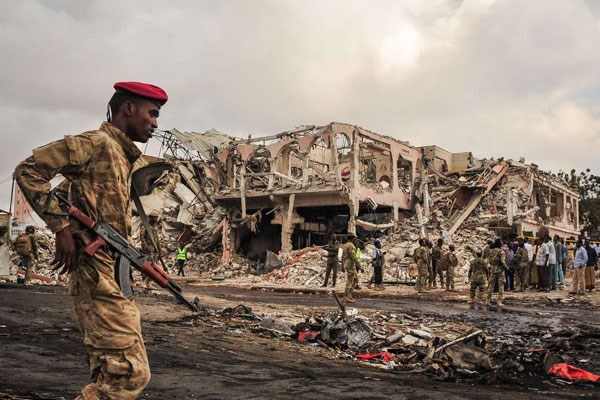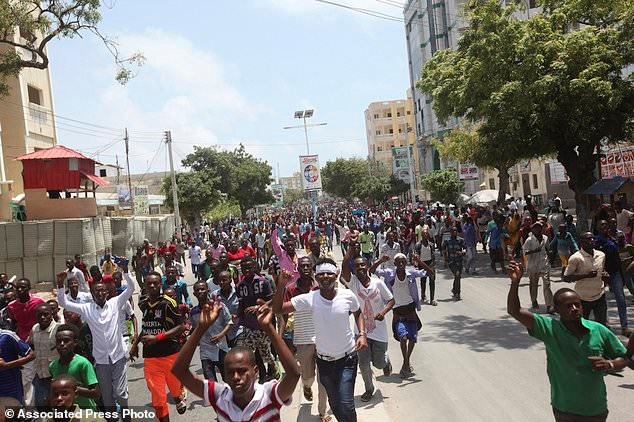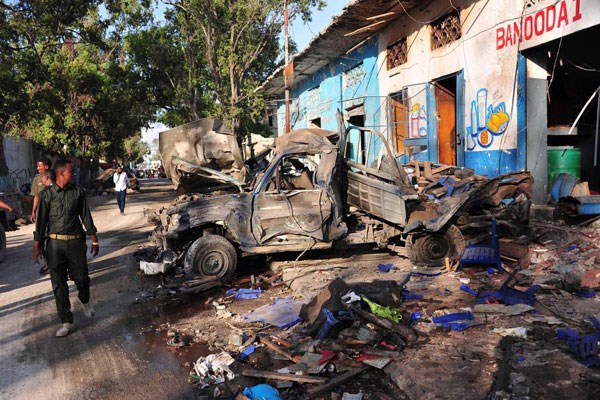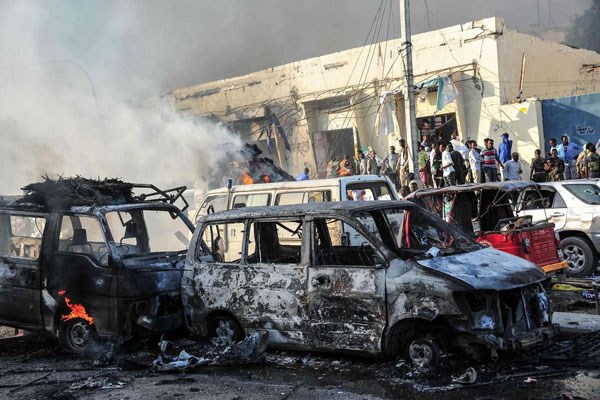
Saturday December 30, 2017
By NURDDIN FARAH Somali soldiers on October 15, 2017, securing the scene of the explosion of a truck bomb in the centre of Mogadishu. This is Somalia’s deadliest attack to date and it killed more than 500 people, showing the capacity of Al Shabaab to take advantage of the flaws of the government of Mogadishu. PHOTO | AFP
Somali soldiers on October 15, 2017, securing the scene of the explosion of a truck bomb in the centre of Mogadishu. This is Somalia’s deadliest attack to date and it killed more than 500 people, showing the capacity of Al Shabaab to take advantage of the flaws of the government of Mogadishu. PHOTO | AFP
On the second day of my visit to Mogadishu, within a couple of days of the October 14, 2017 truck bombing, I visited the site of the explosion in the company of Prof Abdullahi Shirwa, the chairman of the National Emergency Operation Centre.
At some point, the man explaining things to me, glanced nervously around, and bent down and picked up “something.” He said to me, “Here,” offering me whatever it was that he had picked up from under a piece of wood.
I didn’t like his bothered look and so I asked, “What is it?”
“These are pieces of human flesh.”
Shocked, I averted my eyes, not ready to accept the man’s extended hand and was relieved when Prof Shirwa assured me that they were fragments of charred metal strewn by the massive explosion.
The local terrorist group Al Shabaab had just served notice on everyone that it was still capable of striking panic into the nation’s heart, despite its territorial loss. As we mourned the dead, we sought answers to the question we have been asking for the past decade.
Now we ask again if this would be the watershed event that would drive the African Mission in Somalia (Amisom) and the Somali National Army towards a decisive final push to rid the country of Al Shabaab once for all.
'Lies have short legs'
The terrorist organisation — masters in the dark arts of stonewalling — did not claim ownership of the attack, fearing a popular backlash.
It is worth remembering that the terrorists did not own up to the December 4, 2009, Hotel Shamo blast in which a male suicide bomber disguised as a woman by wearing a hijab, detonated a device killing three government ministers, two professors of medicine and nine students at a medical school graduation ceremony. But even without taking credit for the killings, everyone suspected them of being the perpetrators.
A Somali proverb says; Lies have short legs. And sooner or later, the truth will catch up with them.
And so it was something of a relief when the truth caught up with Al Shabaab’s taciturnity: The Somali Minister for Internal Security released the names of the six men behind the October 14 truck bombing a month after the deadly incident and two weeks following the Hotel Naasa Hablood assault, in which 17 people died and 23 were wounded, which Al Shabaab claimed to have carried out.
Mohamed Abukar Islow, the minister for Internal Security, identified Osman Hajji aka Maadey as the suicide bomber and driver of the truck. He also named five other individuals, who are now in custody, accused of having had a hand in the bombing: Hassan Adan Isack, the driver of the second car; Ali Yussuf Wacays, aka Duaale, thought to be the second suicide bomber; Abdiweli Ahmed Dirie, aka Fanax, the group’s head of explosive experts in Mogadishu; Mukhtar Mohamed known as Gardhuub, a senior leader of the team; and Abdullahi Abdi Warsame.
The minister added, “Apart from those in custody, our forces are hunting down the owner of the truck who is on the run.”
The government also shared the CCTV recording showing the truck at the moment it started colliding with other vehicles near the intersection, with security cars in pursuit. Angry
protesters march near the scene of Saturday's massive truck bomb attack
in which over 300 people were killed in Mogadishu, Somalia, Wednesday,
Oct. 18, 2017. Thousands of people took to the streets of Somalia's
capital Wednesday in a show of defiance after the country's deadliest
attack, as two people were arrested in connection with Saturday's
massive truck bombing that killed more than 300. (AP Photo/Farah Abdi
Warsameh)
Angry
protesters march near the scene of Saturday's massive truck bomb attack
in which over 300 people were killed in Mogadishu, Somalia, Wednesday,
Oct. 18, 2017. Thousands of people took to the streets of Somalia's
capital Wednesday in a show of defiance after the country's deadliest
attack, as two people were arrested in connection with Saturday's
massive truck bombing that killed more than 300. (AP Photo/Farah Abdi
Warsameh)
There is a lot we do not know and maybe we will never know. I questioned both the recently fired National Security chief Abdullahi Mohamed Sanbalolshe and the minister of internal security about how a truck loaded with about a thousand kilogrammes of explosives was allowed to pass through numerous checkpoints, skirt the capital’s security cordons, and enter the city without it being stopped.
Perhaps the officers manning the checkpoints were corrupt, because they had not received their salaries for months, I suggested, but neither man agreed. Still, the versions given are in conflict with one another, but I have reconstructed the stories as told by different sources.
Runaway truck
In one version, the officers at the final police check point stopped the truck and instructed the driver to park it and get out. Questioned about the cargo and its owner, the driver volunteered the name of the businessman who owned the consignment.
With no sniffer dogs in situ that day, the most senior officer makes do: He had the elderly businessman, who vouches for the driver and a younger man arriving at the scene, and a nephew of the businessman stand in front of the truck, and took photographs of them with the licence plate showing. He attaches the photo to a signed affidavit.
While the senior officer and the two men are busy with the paperwork, a well-meaning young officer instructs the driver to move the truck further along on the roadside to allow traffic to flow. The driver, once in the truck, takes off towards the city.
The officers at the check point appraise the authorities of the now runaway truck before giving chase.
Within minutes, the driver, as he approached the busy Zoobe Junction, crossed the median smashing into oncoming traffic. But when he realised that he was trapped, he detonated a bomb at the junction — he was surrounded by other vehicles and by cataclysmic happenstance, a fuel truck was also parked nearby. And just like that, 400 people lost their lives and hundreds suffered life-threatening injuries.
Meanwhile, another driver in a smaller vehicle, a Toyota Noah van, was waiting on a side street, presumably to give or take instructions since neither his rendezvous with the suicide bomber nor the encounter with the truck had occurred. This driver was within the proximity of the Aden Abdulle International Airport, with his engine idling.
A police officer approached him to ask him to move along, and since the driver was talking on the phone and did not react to the instructions, the policeman moved closer to inspect the vehicle and that was when he noticed a web of wires. The officer, now joined by his partner, yanked the driver’s door open, grabbed the man by the scruff of his shirt and dragged him away from the car. The bomb exploded. But the two officers and the terrorist escaped unhurt. The terrorist was taken into custody.
Truck from Italy
According to Panorama, an Italian magazine, the truck used in the bombing is one of Italy’s army military vehicles that was dismantled piece by piece and bolt by bolt, boxed and shipped to Somalia via Antwerp port in Belgium.
A criminal group of Italians and Somalis working for an auto body shop in the Province of Pisa had shipped the separate parts to Mogadishu, where it was reassembled. In Italy, 16 people, four of them Somalis, have been accused of involvement and arrested. The
scene from the street on October 29, 2017, a day after two car bombs
exploded in Mogadishu. The attack began when a car bomb exploded outside
the hotel entrance, followed by a minibus loaded with explosives going
off at a nearby intersection. PHOTO | AFP
The
scene from the street on October 29, 2017, a day after two car bombs
exploded in Mogadishu. The attack began when a car bomb exploded outside
the hotel entrance, followed by a minibus loaded with explosives going
off at a nearby intersection. PHOTO | AFP
A man called Abdullahi Ibrahim Hassan bought the military truck on August 18, 2017. Nearly a month later, the truck driver made a number of dry runs from Afgoi into the city. The intention was for the driver to familiarise himself with officers at the various check points by ferrying quintals of maize.
The first recorded trip was made on September 13, 2017. The Federal Minister of Internal Security claims a different man called Abdullahi Abdi Warsame, currently in detention, paid for the vehicle’s licence on behalf of the registered owner, who to date is still on the run.
How the country got here
Alone in my hotel room late that evening following my meeting with the minister of Internal Security, his bodyguards hovering nearby, I recalled a conversation I had in London with a leading British scholar on Jihadi insurgency in Somalia.
My English friend said, “Do you know why the majority Muslim countries like Somalia, Pakistan and Afghanistan serve as religious battlefields, when no majority Arab country has ever been torn apart by similar religion-based conflicts until Isis appeared on the scene?”
“It is because Qatar, United Arab Emirate and Saudi Arabia pay the wages of the Jihadis on the proviso that all the religious battles are fought elsewhere, away from their countries. Osama bin Laden operated from his Afghan base until his stay in that country became untenable. Then he moved his base to Pakistan,” he explained simply.
“Where does Somalia fit in?” I asked.
The analyst claimed that it all began when Gen Mohamed Farah Aideed met Osama bin Laden, the leader of Al Qaeda, at the latter’s retreat in Soba, an ancient Nubian city about 20 kilometres away from Khartoum. In 1997, bin Laden would later tell two CNN journalists that his men had trained the Somalis in downing the US military helicopters Black Hawks by aiming at the tail rotors.
Bin Laden dispatched Abu Hafs Al Masri, the Egyptian, to provide on-the-ground training to Aideed’s militiamen on downing a helicopter. When the two met, bin Laden was living openly in Khartoum and putting together a plan to launch the twin attacks on the US embassies in Nairobi and Dar es Salaam. A few years later his men carried out the game-changing 9/11 assaults on the Twin Towers in New York.
Foreign interests
A lot has happened in Somalia since the Black Hawk Down days caused the US to withdraw its army. It seemed as if Somalis were left to their own devices to deal with the nefarious interference in the country’s affairs by Ethiopia, Kenya, Eritrea, Uganda, the US, the EU and a handful of Arab states, each having its own self-serving design, some in an underhand way, others with worrying blatancy.
A rap sheet of crimes was committed against Somalia: The country’s wealth looted, its seas emptied of fish, its shores polluted with nuclear and chemical waste and the chance of it putting a government together continuously sabotaged by one foreign party or another.
When I visited Mogadishu in 1996 after a 22-year exile, I found a divided city run by two warlords, each claiming a half as his fiefdom. And with no government to provide civic amenities and no functioning state-run schools, the Qataris, the Saudis and the Emiratis entered Somalia especially in the education sector, as if to bring bin Laden’s plans finally into fruition.
Under Siad Barre, Somalia had been a secular state, quite unlike any other Muslim nation. Now the Arabs had a free rein to impose their language, harden the Somalis’ moderate way of worship and change the traditional manner in which our people dressed.
Unchallenged, the Saudis, the Qataris and the Emiratis introduced their own school curricula, which was adopted by the teachers whose salaries they paid. In 10 years, the Islamic Courts Union exerted control over much of southern Somalia. The US awoke to the “dangers” the Courts could present and gave its tacit approval to Ethiopia to invade. And Al Shabaab, as the Court’s offshoot, emerged.
Thus while the Arab states’ threat to Somali sovereignty has its origin in bin Laden’s secret pact with Aideed through a series of permutations, the snake ended up biting its tail — morphing into Al Shabaab. Now with the appearance of Turkey on the scene, the Arab subversion of Somalia as a self-governing state has become more sinister and may lead to civil war.
The country today
Without a federal government statement on the truck bombing and with Al Shabaab also keeping mum, Somalis can only speculate about the perpetrators. The Guardian ascribed a clan motive to the bombing and in reaction to this, the elders from the fingered community condemned the newspaper, stating that this made no sense, since this clan claimed to have lost 180 of their kith and kin in the explosion.
The Doha-based network Al Jazeera entered the fray, speculating that the Turkish Military Academy was the bombers’ intended target. But the rumour that the UAE was behind the bombing gained more currency by the day among Mogadishians, with many Somalis describing the Emirates as the agent of destruction, because of connections to the heads of the regional governments. It is no secret that the Saudi and UAE governments view Turkey with suspicion, a threat to their political designs.
The truck bombing of October 14 was followed a fortnight later by another, albeit less disastrous, assault on Hotel Naasa Hablood. This attack bore all Al Shabaab’s signature traits: A small vehicle smashed the gate of the hotel open creating panic and confusion, then a group armed with assault rifles and wearing suicide vests walked in and finished the job.
That Al Shabaab could stage yet another attack so soon after the massacre at Zoobe Junction shocked the nation and further deflated the earlier sense of optimism about the country.
A sense of hopelessness and defeat spread to the government, with politicians rebuking state security for failing to protect the nation, some asking for the president’s and the prime minister’s heads. So the president went on a whistle-stop tour of the troop-contributing countries; Uganda, Ethiopia, Burundi, Kenya and Djibouti, seeking their assistance.
The wreckage of vehicles following the explosion of a truck bomb in the centre of Mogadishu on October 14, 2017. PHOTO | AFP
Amisom is anathema
Not for the first time, Amisom came in for some serious blame, because both its top officers and foot soldiers have been accused of blatant corruption as well as indifference to the job at hand.
In an article published in The EastAfrican on November 7, 2017, Charles Onyango-Obbo wrote, “There is a higher level of consensus between the Amisom and Al Shabaab than between the leaders of the contributing countries.” This is because “Amisom does business with A Shabaab,” to whom the troops sell arms.
I can attest to the thick-as-thieves-closeness between the Ugandans at the airport and some of the Somalis they have dealings with. The UN Monitoring Unit has accused the Kismayu-based Kenyan contingent of making money from the sale of charcoal. And there is a feeling that Ethiopia is in Somalia for its strategic reasons. This is why the presence of Amisom is anathema to national self-esteem.
Matt Bryden, the Canadian security expert on matters Somali noted to me that the charitable view, which is not entirely incorrect, is that Amisom has “secured” major Somali towns, especially Mogadishu and regional/state capitals, and therefore established adequate physical space for Somali political processes and institutions to evolve. Without them, it’s hard to imagine the existence of the federal government, state governments, or parliaments, whatever their shortcomings.
He goes on; “On the other hand, Amisom forces have failed to achieve in 10 years what Ethiopian troops achieved in less than a week: domination of Somali territory between Gaalkacyo and Ras Kamboni. Which is not to say that the Ethiopian intervention was either desirable or a success: simply that from the perspective of military effectiveness, Amisom leaves much to be desired.”
I pressed him some more, and he wrote, “We probably still need Amisom to protect major towns until Somali forces are able to relieve them. But it’s unrealistic to expect them to do so, because they are ill equipped in all respects to take the fight to Al Shabaab and to pursue them into rural areas or embark on some kind of counter-insurgency campaign. If they leave now, this would almost certainly make things worse and end in disaster. Apart from taking the remaining Al Shabaab strongholds of Jilib, Jamame and Sakow, Amisom has probably reached the limits of its utility.”
Somali security structures
Confusion reigns supreme when it comes to finding the panacea for Somalia’s security frailties. Upward of 500 US Special Forces are in the country, tasked with targeting Al Shabaab training camps and also to help train Amisom and the Somali National Army.
On top of this, thousands of Somali army units are receiving their training in Uganda, the Sudan as well as Djibouti and thrown into the mix are a Mogadishu-based UAE military facility and a Turkish military academy. The worry is that, with Amisom’s withdrawal ongoing, there is no uniformity or cohesion in the national army of the country.
Time and again, the work of the security apparatus in Somalia has been found wanting and the quality and efficacy of detection has been questioned. In an opinion piece in the New York Times, Mr Sanbalolshe, however, points a finger away from his men and women, explaining that the country does not have forensic labs and lacks the necessary expertise to deal with the investigative challenges arising from the explosions.
He laments the dearth of technical skill in the security structures, all the more made worse by the fact that when the intelligence at the crime scene — explosive residues, the detonators, the sim cards, the DNA of the perpetrators and fingerprints — is gathered and removed by Somalia’s US, British and UN partners, the results of the investigation are neither returned nor is the information shared with Somalia intelligence.
Describing the nation’s partners as unscrupulous carpetbaggers with unconscionable meanness, he argues that this lack of information sharing is hampering the decision-making of the security structures.
With the Somali National Army not equipped to take over from Amisom, and Amisom engaged in corruption and selling weapons to Al Shabaab, Kenya accused of exporting charcoal, Ethiopia suspected of having its own designs, the US, Britain and the UN’s information-sharing not forthcoming, is there any wonder why there has been no tangible progress in the fight against the terrorists in Somalia?
Unless the arms embargo is lifted and there is cohesion in the way Somalia’s partners collaborate with its security apparatus, my fear is that we will witness an attack a lot worse than the one on October 14, at Zoobe junction.
Nurddin Farah is a Somali novelist who lives in the US and South Africa.